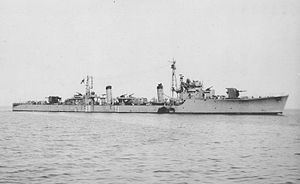Japanese destroyer Kuwa (1944)
 Sister ship Momi, 4 September 1944
| |
| History | |
|---|---|
| Name | Kuwa |
| Namesake | Mulberry |
| Builder | Fujinagata Shipyards, Osaka |
| Laid down | 20 December 1943 |
| Launched | 25 May 1944 |
| Completed | 15 July 1944 |
| Stricken | 10 February 1945 |
| Fate | Sunk by gunfire, 3 December 1944 |
| General characteristics (as built) | |
| Class and type | Matsu-class escort destroyer |
| Displacement | 1,282 t (1,262 long tons) (standard) |
| Length | 100 m (328 ft 1 in) (o/a) |
| Beam | 9.35 m (30 ft 8 in) |
| Draft | 3.3 m (10 ft 10 in) |
| Installed power | 2 × water-tube boilers; 19,000 shp (14,000 kW) |
| Propulsion | 2 shafts, 2 × geared steam turbines |
| Speed | 27.8 knots (51.5 km/h; 32.0 mph) |
| Range | 4,680 nmi (8,670 km; 5,390 mi) at 16 knots (30 km/h; 18 mph) |
| Complement | 210 |
| Sensors and processing systems |
|
| Armament |
|
Kuwa (桑, "Mulberry") was one of 18 Matsu-class escort destroyers built for the Imperial Japanese Navy during World War II.
Completed on 25 July 1944, Kuwa was assigned to Desron 11 of the Combined Fleet for training. Organizational demands meant she spent the next three months attached to Desdiv 43 (an antisubmarine formation) while officially part of Desron 11.
Kuwa's assignment to Desdiv 43 was formalized shortly before the Battle of Leyte Gulf, where she was part of the escort for the Northern Force. After Zuihō sank, Kuwa rescued the majority of her survivors, so overloading the small destroyer that they had to be forbidden from moving until some could be transferred to other ships at Okinawa.
Afterwards, Kuwa returned to Kure for minor repairs, then escorted the battleships Ise and Hyūga during their transportation run to Manila. Massive air raids deterred the battleships from completing the journey; their cargo was transferred to fast transports at the Spratly Islands, which Kuwa and others escorted through to Manila Bay. Kuwa spent the next two weeks operating near Manila.
Kuwa's final operation was to escort convoy TA-7 from Manila to Ormoc Bay. Reaching the destination late on 2 December 1944, Kuwa took up a patrol position seaward of the unloading convoy, while her sister Take took on survivors from a previous convoy. Unfortunately for Kuwa, this meant that when three American destroyers attacked just after midnight, she was their first target. Charging to meet the enemy, Kuwa was savaged by gunfire, out of action by 0020 and sinking thereafter. She did not go down alone, however; USS Cooper was hit by a torpedo, broke in two, and also sank. The two remaining American destroyers fled, fearing Japanese reprisal; Take and the convoy also hastily departed, only rescuing eight of Kuwa's survivors as they passed. Many made it to shore, but some were still afloat when US forces returned to rescue Cooper's survivors, and were taken prisoner.
Kuwa was struck from the Navy List on 10 February 1945.
Bibliography[]
- Jentschura, Hansgeorg; Jung, Dieter & Mickel, Peter (1977). Warships of the Imperial Japanese Navy, 1869–1945. Annapolis, Maryland: United States Naval Institute. ISBN 0-87021-893-X.
- Nevitt, Allyn D. (1998). "IJN Kuwa: Tabular Record of Movement". www.combinedfleet.com. Retrieved 21 September 2020.
- Rohwer, Jürgen (2005). Chronology of the War at Sea 1939–1945: The Naval History of World War Two (Third Revised ed.). Annapolis, Maryland: Naval Institute Press. ISBN 1-59114-119-2.
- Stille, Mark (2013). Imperial Japanese Navy Destroyers 1919–45 (2): Asahio to Tachibana Classes. Botley, UK: Osprey Publishing. ISBN 978-1-84908-987-6.
- Sturton, Ian (1980). "Japan". In Chesneau, Roger (ed.). Conway's All the World's Fighting Ships 1922–1946. Greenwich, UK: Conway Maritime Press. ISBN 0-85177-146-7.
- Whitley, M. J. (1988). Destroyers of World War Two: An International Encyclopedia. Annapolis, Maryland: Naval Institute Press. ISBN 0-87021-326-1.
External links[]
- Nevitt, Allyn D. (2013). "IJN Kuwa: Tabular Record of Movement". Long Lancers. Combinedfleet.com. Retrieved 23 June 2021.
- Matsu-class destroyers
- Ships built by Fujinagata Shipyards
- World War II destroyers of Japan
- 1944 ships